BUSN617 Research Methods: Digital Transformation in Amazon Warehouses
VerifiedAdded on 2023/06/10
|7
|1813
|407
Literature Review
AI Summary
This literature review examines the automation and digitization of work within Amazon warehouses, focusing on the impact of digital technology, artificial intelligence, and smart systems on organizational behavior. It analyzes existing research to identify gaps in understanding how these technologies affect team dynamics, workforce efficiency, and overall output. The review covers topics such as digital capitalism, the role of algorithms, unionization efforts, and the evolution of labor practices in response to smart warehouse technologies. The study proposes further research to explore how digital technology influences organizational behavior at Amazon warehouses, aiming to develop strategies for managing employee concerns and optimizing the use of technology in logistics operations. This assignment is available on Desklib, a platform offering study tools and resources for students.
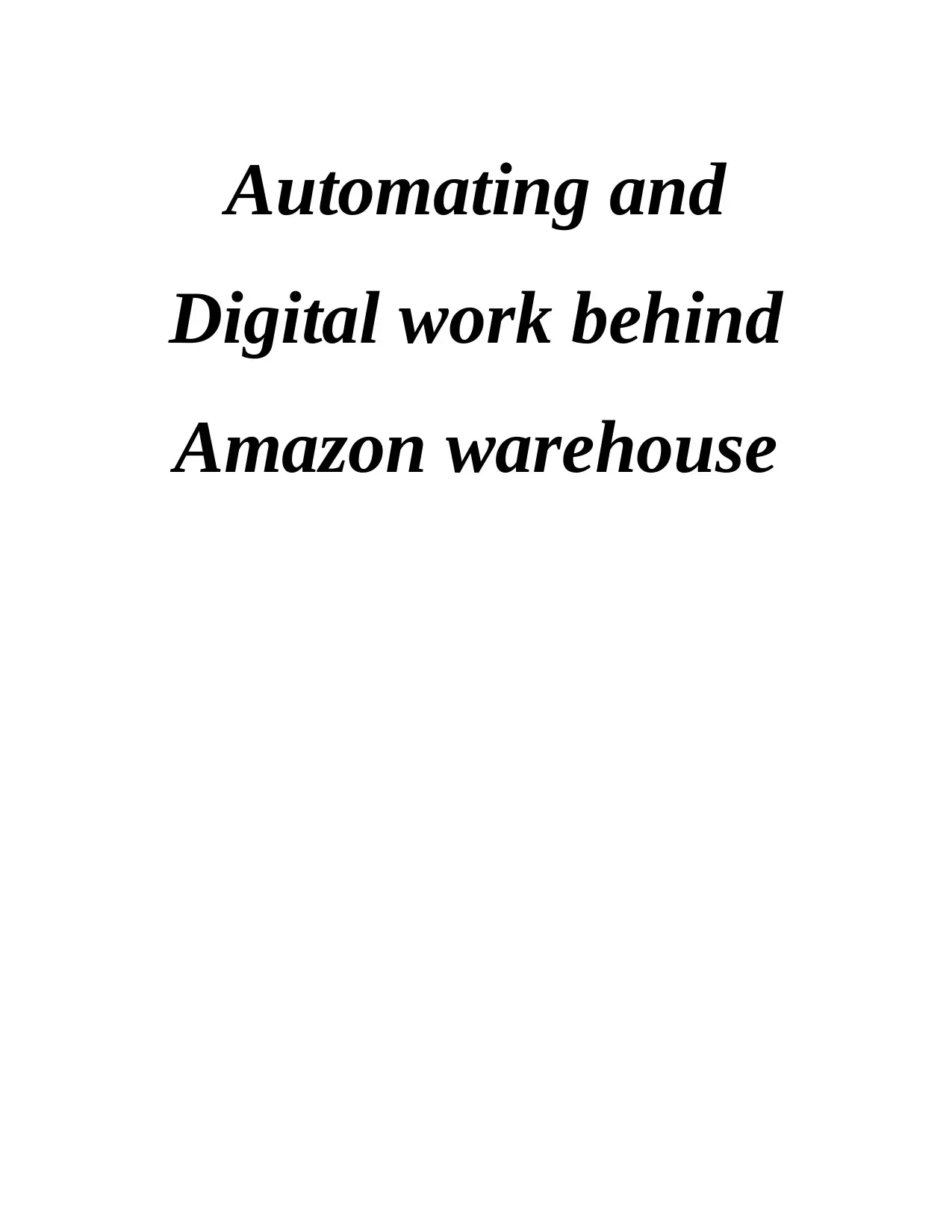
Automating and
Digital work behind
Amazon warehouse
Digital work behind
Amazon warehouse
Paraphrase This Document
Need a fresh take? Get an instant paraphrase of this document with our AI Paraphraser

Contents
SECTION 1......................................................................................................................................1
Literature Review...................................................................................................................1
SECTION 2......................................................................................................................................2
Problemtaization.....................................................................................................................2
SECTION 3......................................................................................................................................3
REFRENCES...................................................................................................................................4
SECTION 1......................................................................................................................................1
Literature Review...................................................................................................................1
SECTION 2......................................................................................................................................2
Problemtaization.....................................................................................................................2
SECTION 3......................................................................................................................................3
REFRENCES...................................................................................................................................4
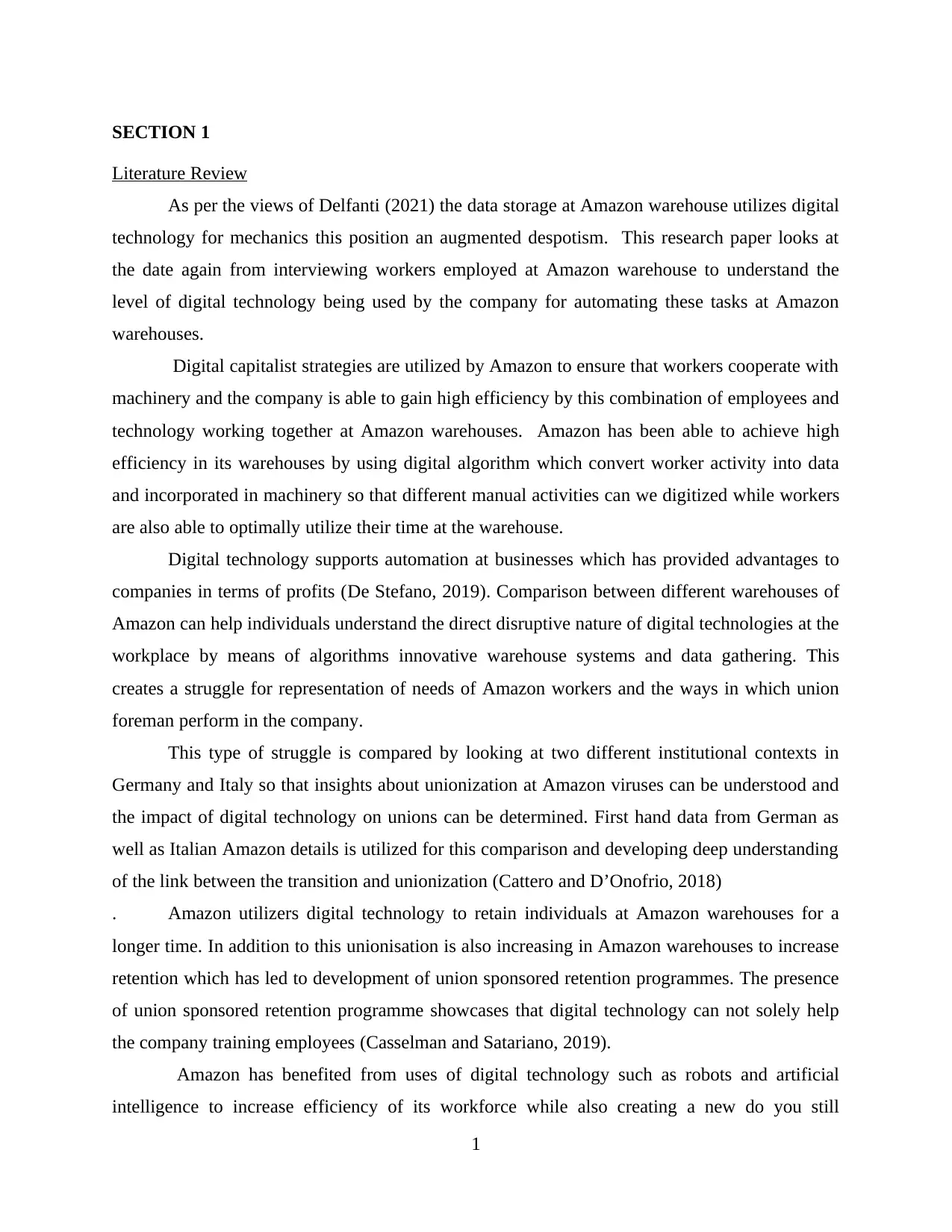
SECTION 1
Literature Review
As per the views of Delfanti (2021) the data storage at Amazon warehouse utilizes digital
technology for mechanics this position an augmented despotism. This research paper looks at
the date again from interviewing workers employed at Amazon warehouse to understand the
level of digital technology being used by the company for automating these tasks at Amazon
warehouses.
Digital capitalist strategies are utilized by Amazon to ensure that workers cooperate with
machinery and the company is able to gain high efficiency by this combination of employees and
technology working together at Amazon warehouses. Amazon has been able to achieve high
efficiency in its warehouses by using digital algorithm which convert worker activity into data
and incorporated in machinery so that different manual activities can we digitized while workers
are also able to optimally utilize their time at the warehouse.
Digital technology supports automation at businesses which has provided advantages to
companies in terms of profits (De Stefano, 2019). Comparison between different warehouses of
Amazon can help individuals understand the direct disruptive nature of digital technologies at the
workplace by means of algorithms innovative warehouse systems and data gathering. This
creates a struggle for representation of needs of Amazon workers and the ways in which union
foreman perform in the company.
This type of struggle is compared by looking at two different institutional contexts in
Germany and Italy so that insights about unionization at Amazon viruses can be understood and
the impact of digital technology on unions can be determined. First hand data from German as
well as Italian Amazon details is utilized for this comparison and developing deep understanding
of the link between the transition and unionization (Cattero and D’Onofrio, 2018)
. Amazon utilizers digital technology to retain individuals at Amazon warehouses for a
longer time. In addition to this unionisation is also increasing in Amazon warehouses to increase
retention which has led to development of union sponsored retention programmes. The presence
of union sponsored retention programme showcases that digital technology can not solely help
the company training employees (Casselman and Satariano, 2019).
Amazon has benefited from uses of digital technology such as robots and artificial
intelligence to increase efficiency of its workforce while also creating a new do you still
1
Literature Review
As per the views of Delfanti (2021) the data storage at Amazon warehouse utilizes digital
technology for mechanics this position an augmented despotism. This research paper looks at
the date again from interviewing workers employed at Amazon warehouse to understand the
level of digital technology being used by the company for automating these tasks at Amazon
warehouses.
Digital capitalist strategies are utilized by Amazon to ensure that workers cooperate with
machinery and the company is able to gain high efficiency by this combination of employees and
technology working together at Amazon warehouses. Amazon has been able to achieve high
efficiency in its warehouses by using digital algorithm which convert worker activity into data
and incorporated in machinery so that different manual activities can we digitized while workers
are also able to optimally utilize their time at the warehouse.
Digital technology supports automation at businesses which has provided advantages to
companies in terms of profits (De Stefano, 2019). Comparison between different warehouses of
Amazon can help individuals understand the direct disruptive nature of digital technologies at the
workplace by means of algorithms innovative warehouse systems and data gathering. This
creates a struggle for representation of needs of Amazon workers and the ways in which union
foreman perform in the company.
This type of struggle is compared by looking at two different institutional contexts in
Germany and Italy so that insights about unionization at Amazon viruses can be understood and
the impact of digital technology on unions can be determined. First hand data from German as
well as Italian Amazon details is utilized for this comparison and developing deep understanding
of the link between the transition and unionization (Cattero and D’Onofrio, 2018)
. Amazon utilizers digital technology to retain individuals at Amazon warehouses for a
longer time. In addition to this unionisation is also increasing in Amazon warehouses to increase
retention which has led to development of union sponsored retention programmes. The presence
of union sponsored retention programme showcases that digital technology can not solely help
the company training employees (Casselman and Satariano, 2019).
Amazon has benefited from uses of digital technology such as robots and artificial
intelligence to increase efficiency of its workforce while also creating a new do you still
1
⊘ This is a preview!⊘
Do you want full access?
Subscribe today to unlock all pages.

Trusted by 1+ million students worldwide
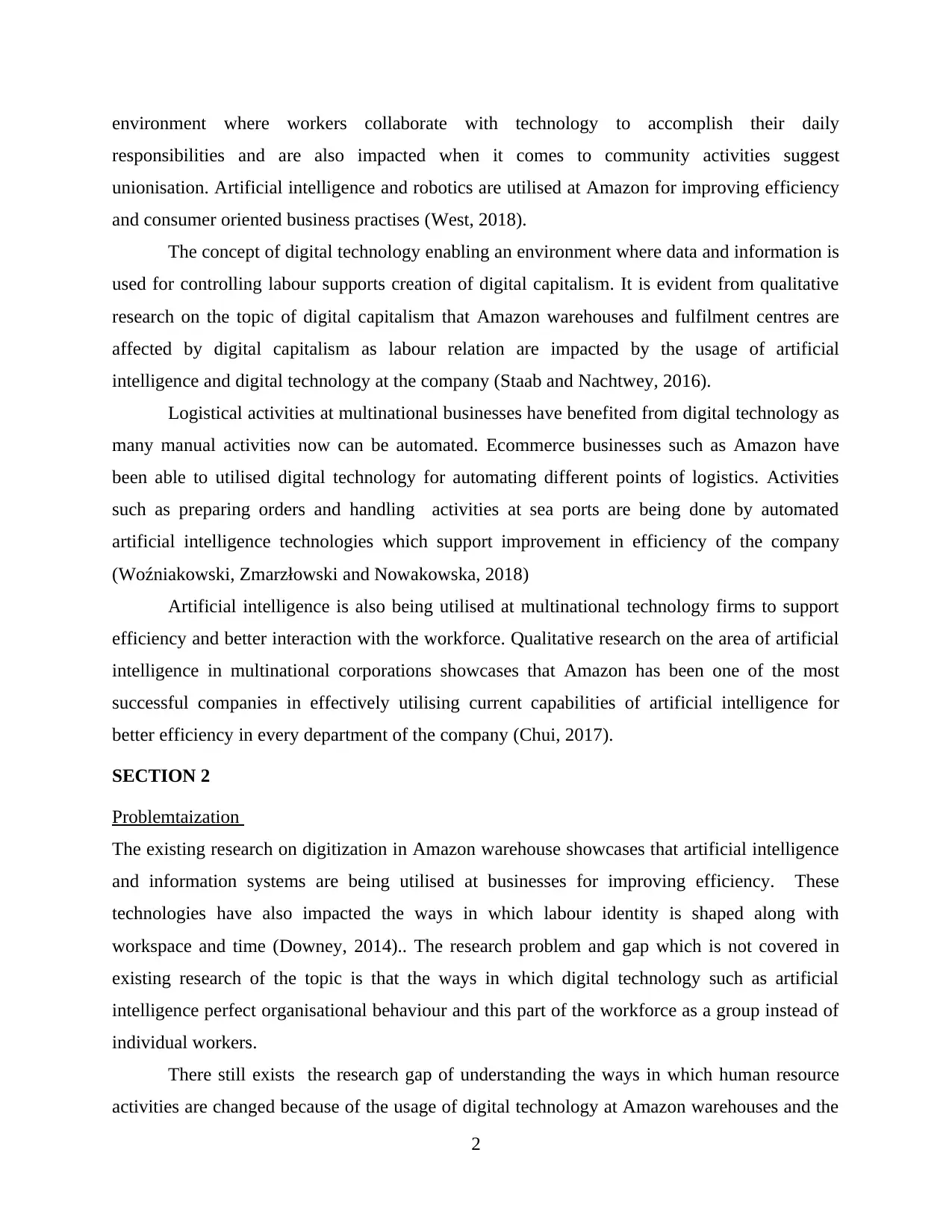
environment where workers collaborate with technology to accomplish their daily
responsibilities and are also impacted when it comes to community activities suggest
unionisation. Artificial intelligence and robotics are utilised at Amazon for improving efficiency
and consumer oriented business practises (West, 2018).
The concept of digital technology enabling an environment where data and information is
used for controlling labour supports creation of digital capitalism. It is evident from qualitative
research on the topic of digital capitalism that Amazon warehouses and fulfilment centres are
affected by digital capitalism as labour relation are impacted by the usage of artificial
intelligence and digital technology at the company (Staab and Nachtwey, 2016).
Logistical activities at multinational businesses have benefited from digital technology as
many manual activities now can be automated. Ecommerce businesses such as Amazon have
been able to utilised digital technology for automating different points of logistics. Activities
such as preparing orders and handling activities at sea ports are being done by automated
artificial intelligence technologies which support improvement in efficiency of the company
(Woźniakowski, Zmarzłowski and Nowakowska, 2018)
Artificial intelligence is also being utilised at multinational technology firms to support
efficiency and better interaction with the workforce. Qualitative research on the area of artificial
intelligence in multinational corporations showcases that Amazon has been one of the most
successful companies in effectively utilising current capabilities of artificial intelligence for
better efficiency in every department of the company (Chui, 2017).
SECTION 2
Problemtaization
The existing research on digitization in Amazon warehouse showcases that artificial intelligence
and information systems are being utilised at businesses for improving efficiency. These
technologies have also impacted the ways in which labour identity is shaped along with
workspace and time (Downey, 2014).. The research problem and gap which is not covered in
existing research of the topic is that the ways in which digital technology such as artificial
intelligence perfect organisational behaviour and this part of the workforce as a group instead of
individual workers.
There still exists the research gap of understanding the ways in which human resource
activities are changed because of the usage of digital technology at Amazon warehouses and the
2
responsibilities and are also impacted when it comes to community activities suggest
unionisation. Artificial intelligence and robotics are utilised at Amazon for improving efficiency
and consumer oriented business practises (West, 2018).
The concept of digital technology enabling an environment where data and information is
used for controlling labour supports creation of digital capitalism. It is evident from qualitative
research on the topic of digital capitalism that Amazon warehouses and fulfilment centres are
affected by digital capitalism as labour relation are impacted by the usage of artificial
intelligence and digital technology at the company (Staab and Nachtwey, 2016).
Logistical activities at multinational businesses have benefited from digital technology as
many manual activities now can be automated. Ecommerce businesses such as Amazon have
been able to utilised digital technology for automating different points of logistics. Activities
such as preparing orders and handling activities at sea ports are being done by automated
artificial intelligence technologies which support improvement in efficiency of the company
(Woźniakowski, Zmarzłowski and Nowakowska, 2018)
Artificial intelligence is also being utilised at multinational technology firms to support
efficiency and better interaction with the workforce. Qualitative research on the area of artificial
intelligence in multinational corporations showcases that Amazon has been one of the most
successful companies in effectively utilising current capabilities of artificial intelligence for
better efficiency in every department of the company (Chui, 2017).
SECTION 2
Problemtaization
The existing research on digitization in Amazon warehouse showcases that artificial intelligence
and information systems are being utilised at businesses for improving efficiency. These
technologies have also impacted the ways in which labour identity is shaped along with
workspace and time (Downey, 2014).. The research problem and gap which is not covered in
existing research of the topic is that the ways in which digital technology such as artificial
intelligence perfect organisational behaviour and this part of the workforce as a group instead of
individual workers.
There still exists the research gap of understanding the ways in which human resource
activities are changed because of the usage of digital technology at Amazon warehouses and the
2
Paraphrase This Document
Need a fresh take? Get an instant paraphrase of this document with our AI Paraphraser
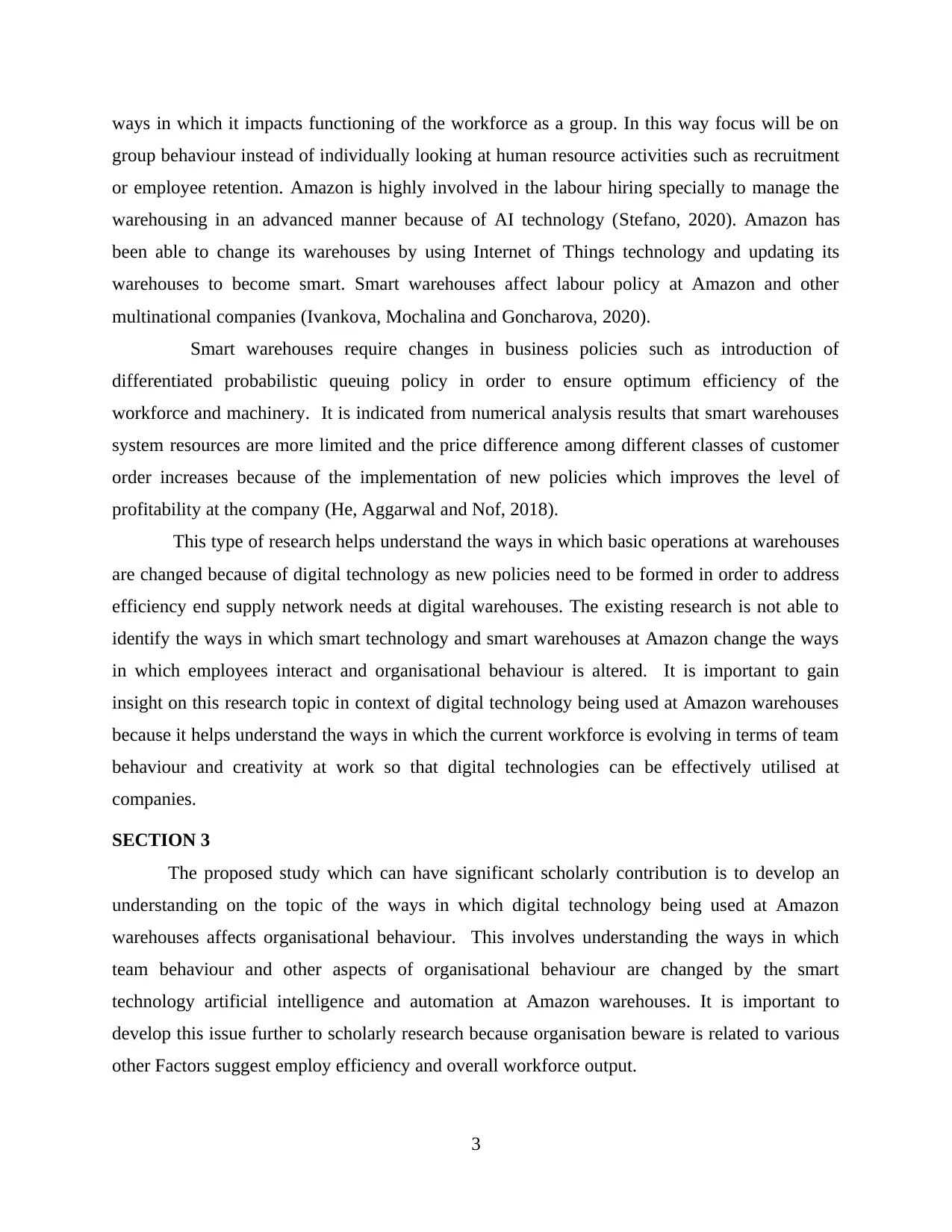
ways in which it impacts functioning of the workforce as a group. In this way focus will be on
group behaviour instead of individually looking at human resource activities such as recruitment
or employee retention. Amazon is highly involved in the labour hiring specially to manage the
warehousing in an advanced manner because of AI technology (Stefano, 2020). Amazon has
been able to change its warehouses by using Internet of Things technology and updating its
warehouses to become smart. Smart warehouses affect labour policy at Amazon and other
multinational companies (Ivankova, Mochalina and Goncharova, 2020).
Smart warehouses require changes in business policies such as introduction of
differentiated probabilistic queuing policy in order to ensure optimum efficiency of the
workforce and machinery. It is indicated from numerical analysis results that smart warehouses
system resources are more limited and the price difference among different classes of customer
order increases because of the implementation of new policies which improves the level of
profitability at the company (He, Aggarwal and Nof, 2018).
This type of research helps understand the ways in which basic operations at warehouses
are changed because of digital technology as new policies need to be formed in order to address
efficiency end supply network needs at digital warehouses. The existing research is not able to
identify the ways in which smart technology and smart warehouses at Amazon change the ways
in which employees interact and organisational behaviour is altered. It is important to gain
insight on this research topic in context of digital technology being used at Amazon warehouses
because it helps understand the ways in which the current workforce is evolving in terms of team
behaviour and creativity at work so that digital technologies can be effectively utilised at
companies.
SECTION 3
The proposed study which can have significant scholarly contribution is to develop an
understanding on the topic of the ways in which digital technology being used at Amazon
warehouses affects organisational behaviour. This involves understanding the ways in which
team behaviour and other aspects of organisational behaviour are changed by the smart
technology artificial intelligence and automation at Amazon warehouses. It is important to
develop this issue further to scholarly research because organisation beware is related to various
other Factors suggest employ efficiency and overall workforce output.
3
group behaviour instead of individually looking at human resource activities such as recruitment
or employee retention. Amazon is highly involved in the labour hiring specially to manage the
warehousing in an advanced manner because of AI technology (Stefano, 2020). Amazon has
been able to change its warehouses by using Internet of Things technology and updating its
warehouses to become smart. Smart warehouses affect labour policy at Amazon and other
multinational companies (Ivankova, Mochalina and Goncharova, 2020).
Smart warehouses require changes in business policies such as introduction of
differentiated probabilistic queuing policy in order to ensure optimum efficiency of the
workforce and machinery. It is indicated from numerical analysis results that smart warehouses
system resources are more limited and the price difference among different classes of customer
order increases because of the implementation of new policies which improves the level of
profitability at the company (He, Aggarwal and Nof, 2018).
This type of research helps understand the ways in which basic operations at warehouses
are changed because of digital technology as new policies need to be formed in order to address
efficiency end supply network needs at digital warehouses. The existing research is not able to
identify the ways in which smart technology and smart warehouses at Amazon change the ways
in which employees interact and organisational behaviour is altered. It is important to gain
insight on this research topic in context of digital technology being used at Amazon warehouses
because it helps understand the ways in which the current workforce is evolving in terms of team
behaviour and creativity at work so that digital technologies can be effectively utilised at
companies.
SECTION 3
The proposed study which can have significant scholarly contribution is to develop an
understanding on the topic of the ways in which digital technology being used at Amazon
warehouses affects organisational behaviour. This involves understanding the ways in which
team behaviour and other aspects of organisational behaviour are changed by the smart
technology artificial intelligence and automation at Amazon warehouses. It is important to
develop this issue further to scholarly research because organisation beware is related to various
other Factors suggest employ efficiency and overall workforce output.
3
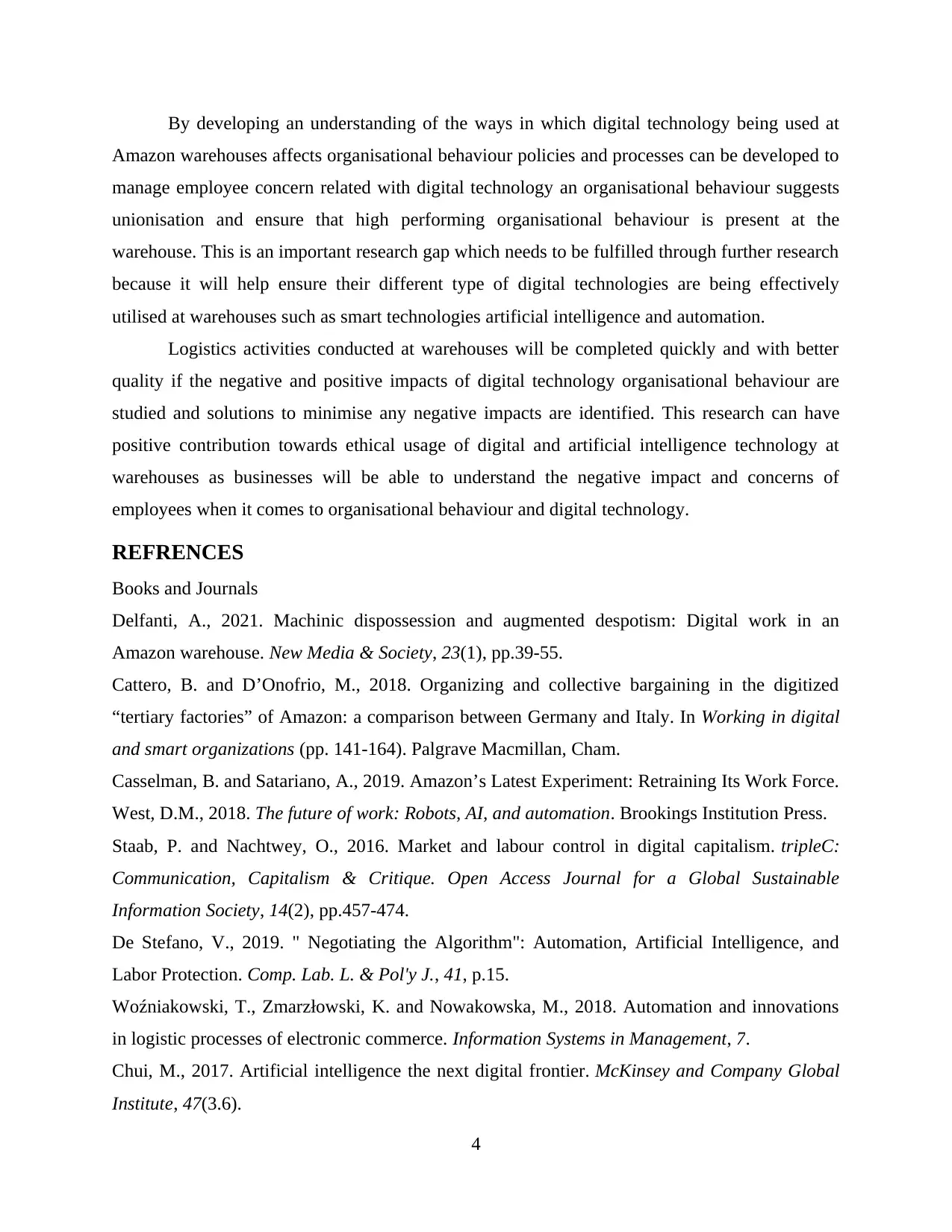
By developing an understanding of the ways in which digital technology being used at
Amazon warehouses affects organisational behaviour policies and processes can be developed to
manage employee concern related with digital technology an organisational behaviour suggests
unionisation and ensure that high performing organisational behaviour is present at the
warehouse. This is an important research gap which needs to be fulfilled through further research
because it will help ensure their different type of digital technologies are being effectively
utilised at warehouses such as smart technologies artificial intelligence and automation.
Logistics activities conducted at warehouses will be completed quickly and with better
quality if the negative and positive impacts of digital technology organisational behaviour are
studied and solutions to minimise any negative impacts are identified. This research can have
positive contribution towards ethical usage of digital and artificial intelligence technology at
warehouses as businesses will be able to understand the negative impact and concerns of
employees when it comes to organisational behaviour and digital technology.
REFRENCES
Books and Journals
Delfanti, A., 2021. Machinic dispossession and augmented despotism: Digital work in an
Amazon warehouse. New Media & Society, 23(1), pp.39-55.
Cattero, B. and D’Onofrio, M., 2018. Organizing and collective bargaining in the digitized
“tertiary factories” of Amazon: a comparison between Germany and Italy. In Working in digital
and smart organizations (pp. 141-164). Palgrave Macmillan, Cham.
Casselman, B. and Satariano, A., 2019. Amazonʼs Latest Experiment: Retraining Its Work Force.
West, D.M., 2018. The future of work: Robots, AI, and automation. Brookings Institution Press.
Staab, P. and Nachtwey, O., 2016. Market and labour control in digital capitalism. tripleC:
Communication, Capitalism & Critique. Open Access Journal for a Global Sustainable
Information Society, 14(2), pp.457-474.
De Stefano, V., 2019. " Negotiating the Algorithm": Automation, Artificial Intelligence, and
Labor Protection. Comp. Lab. L. & Pol'y J., 41, p.15.
Woźniakowski, T., Zmarzłowski, K. and Nowakowska, M., 2018. Automation and innovations
in logistic processes of electronic commerce. Information Systems in Management, 7.
Chui, M., 2017. Artificial intelligence the next digital frontier. McKinsey and Company Global
Institute, 47(3.6).
4
Amazon warehouses affects organisational behaviour policies and processes can be developed to
manage employee concern related with digital technology an organisational behaviour suggests
unionisation and ensure that high performing organisational behaviour is present at the
warehouse. This is an important research gap which needs to be fulfilled through further research
because it will help ensure their different type of digital technologies are being effectively
utilised at warehouses such as smart technologies artificial intelligence and automation.
Logistics activities conducted at warehouses will be completed quickly and with better
quality if the negative and positive impacts of digital technology organisational behaviour are
studied and solutions to minimise any negative impacts are identified. This research can have
positive contribution towards ethical usage of digital and artificial intelligence technology at
warehouses as businesses will be able to understand the negative impact and concerns of
employees when it comes to organisational behaviour and digital technology.
REFRENCES
Books and Journals
Delfanti, A., 2021. Machinic dispossession and augmented despotism: Digital work in an
Amazon warehouse. New Media & Society, 23(1), pp.39-55.
Cattero, B. and D’Onofrio, M., 2018. Organizing and collective bargaining in the digitized
“tertiary factories” of Amazon: a comparison between Germany and Italy. In Working in digital
and smart organizations (pp. 141-164). Palgrave Macmillan, Cham.
Casselman, B. and Satariano, A., 2019. Amazonʼs Latest Experiment: Retraining Its Work Force.
West, D.M., 2018. The future of work: Robots, AI, and automation. Brookings Institution Press.
Staab, P. and Nachtwey, O., 2016. Market and labour control in digital capitalism. tripleC:
Communication, Capitalism & Critique. Open Access Journal for a Global Sustainable
Information Society, 14(2), pp.457-474.
De Stefano, V., 2019. " Negotiating the Algorithm": Automation, Artificial Intelligence, and
Labor Protection. Comp. Lab. L. & Pol'y J., 41, p.15.
Woźniakowski, T., Zmarzłowski, K. and Nowakowska, M., 2018. Automation and innovations
in logistic processes of electronic commerce. Information Systems in Management, 7.
Chui, M., 2017. Artificial intelligence the next digital frontier. McKinsey and Company Global
Institute, 47(3.6).
4
⊘ This is a preview!⊘
Do you want full access?
Subscribe today to unlock all pages.

Trusted by 1+ million students worldwide
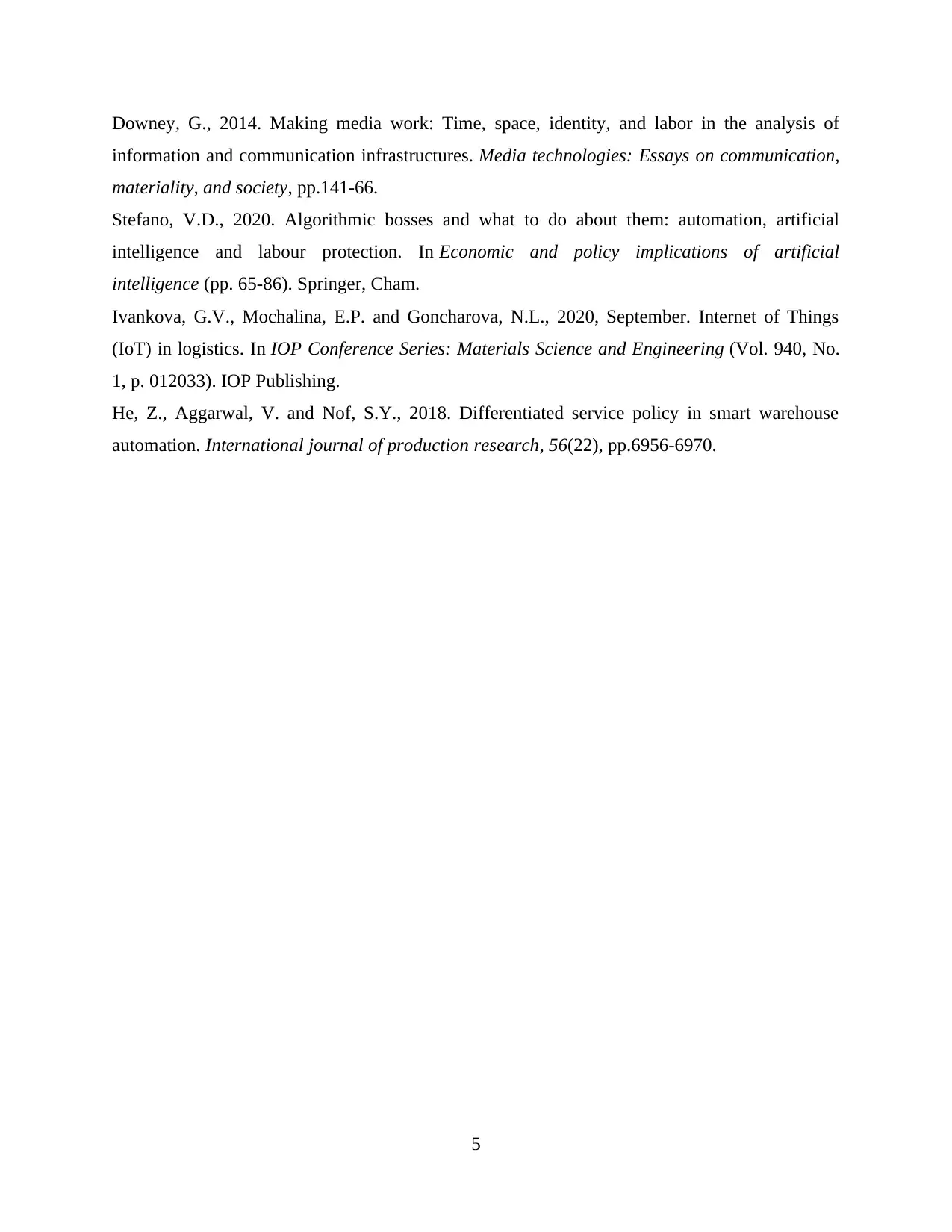
Downey, G., 2014. Making media work: Time, space, identity, and labor in the analysis of
information and communication infrastructures. Media technologies: Essays on communication,
materiality, and society, pp.141-66.
Stefano, V.D., 2020. Algorithmic bosses and what to do about them: automation, artificial
intelligence and labour protection. In Economic and policy implications of artificial
intelligence (pp. 65-86). Springer, Cham.
Ivankova, G.V., Mochalina, E.P. and Goncharova, N.L., 2020, September. Internet of Things
(IoT) in logistics. In IOP Conference Series: Materials Science and Engineering (Vol. 940, No.
1, p. 012033). IOP Publishing.
He, Z., Aggarwal, V. and Nof, S.Y., 2018. Differentiated service policy in smart warehouse
automation. International journal of production research, 56(22), pp.6956-6970.
5
information and communication infrastructures. Media technologies: Essays on communication,
materiality, and society, pp.141-66.
Stefano, V.D., 2020. Algorithmic bosses and what to do about them: automation, artificial
intelligence and labour protection. In Economic and policy implications of artificial
intelligence (pp. 65-86). Springer, Cham.
Ivankova, G.V., Mochalina, E.P. and Goncharova, N.L., 2020, September. Internet of Things
(IoT) in logistics. In IOP Conference Series: Materials Science and Engineering (Vol. 940, No.
1, p. 012033). IOP Publishing.
He, Z., Aggarwal, V. and Nof, S.Y., 2018. Differentiated service policy in smart warehouse
automation. International journal of production research, 56(22), pp.6956-6970.
5
1 out of 7
Your All-in-One AI-Powered Toolkit for Academic Success.
+13062052269
info@desklib.com
Available 24*7 on WhatsApp / Email
![[object Object]](/_next/static/media/star-bottom.7253800d.svg)
Unlock your academic potential
Copyright © 2020–2025 A2Z Services. All Rights Reserved. Developed and managed by ZUCOL.
